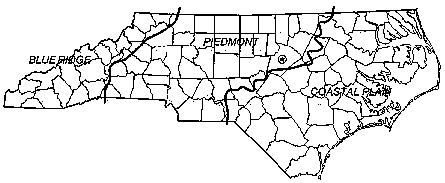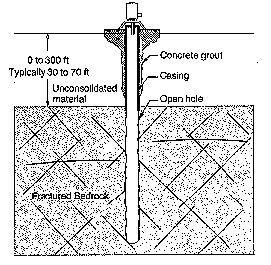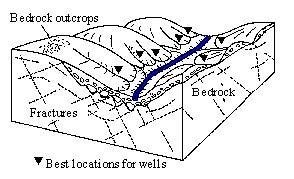Ground water is one of our most important natural resources, as over half of the population of North Carolina depends on it for drinking water. But the increasing pressures of population, industry, and agriculture have placed greater demands on this natural system. If we are to enjoy growth and progress and still protect the ground water in this state, we need to plan carefully to save this precious resource.
What is Ground Water?
The ground beneath our feet is not completely solid. It is more like a sponge with pores of many shapes and sizes. When rain falls, it soaks into the ground and moves through this pore space. In typical soils, 30 to 50 percent of the total volume is pore space. Bedrock has considerably less pore space, often less than 1 percent of the total volume.
The subsurface can be divided into two zones. Close to the surface, in the unsaturated zone, the pores hold both air and water. Further down, in the saturated zone, all of the pore space is filled with water. Water in the saturated zone is called ground water. The boundary between the saturated zone and the unsaturated zone is the water table. A well must reach down below the water table, into the saturated zone, to obtain ground water.
Aquifers and Confining Beds
The word aquikr means "water bearing" in Latin, and it applies to any geologic formation that contains water in sufficient quantity and with sufficient mobility to be useful as a water source.
Beds of sand or gravel usually make excellent aquifers. Although nearly every geologic formation contains water, not all formations allow water to move easily through them. Such compact formations are known as confining beds or aquitards.
Recharge and Discharge
Recharge is the result of the net movement of water down from the ground surface into an aquifer. Recharge areas are usually found in upland regions between streams. When water moves from the aquifer to the surface, discharge occurs. Ground water discharge areas are usually located in low areas close to stream beds. In hilly or mountainous areas, discharge may occur as seeps and springs higher on the slopes.
Geology of the Piedmont and Blue Ridge Provinces
The various landscapes of central and western North Carolina are grouped into two provinces based upon similar landforms (Figure 1). Geologists use the term province to denote broad areas having similar origins and structures.
In many respects, the piedmont and Blue Ridge provinces are very similar. Both are in a relatively advanced state of weathering. Almost all of the soils have formed "in place" by the weathering of underlying rock. (This pattern contrasts with the state of the water-worked sediments of the coastal plain, glaciated regions of the upper Midwest, or wind-deposited soils in the central United States.) The chemical and physical weathering produces a clay-rich layer overlying the bedrock that is typically 30 to 70 feet thick but may be as much as 300 feet deep.
There are several geologically distinct areas in the piedmont province (Figure 2 not available). These areas, known as Triassic basins, formed when deep rifts filled with sediment. The largest of these basins stretches 90 miles from central Moore County to southern Granville County. The three smaller basins are located in Anson, Montgomery, and Richmond counties; Stokes and Rockingham counties; and Davie and Yadkin counties. Many of the sedimentary rocks in these basins are fine-textured and sparsely fractured.
As North Carolina's mountains and ridges were formed, the rock formations underwent extensive up-lifting, folding, and faulting. The stresses of these movements caused the rock to crack, creating a system of fractures. Although individual fractures may extend hundreds of feet. they are typically less than 1/16 of an inch wide.
These bedrock fractures provide a network of channels for water movement. However, they provide very little storage volume. The porosity is often less than 1 percent. Most of the water is stored in the unconsolidated materials overlying the bedrock, where the porositsy may be 20 to 40 percent. The whole system can be compared to a large tank with a network of small pipes connected below it.
Wells
Wells provide access to ground water. We consume ground water in preference to surface water because it undergoes a natural filtration process as it moves down through the soil. Most harmful organisms are filtered out. The soil can react chemically with contaminants in the water, often breaking them down or immobilizing them before they reach the ground water. These natural processes make ground water the safest choice for drinking.
To be effective, the well must provide access to high-quality water, and it must protect that water from contamination. In an improperly constructed well, contaminants can bypass the natural filtration system and move directly into the ground water, fouling the drinking water supply.
Construction
Proper construction of wells is necessary to obtain and protect water quality. Figure 3 illustrates basic construction of a well drilled into fractured bedrock. North Carolina regulations set minimum separations between wells and septic or sewer systems. Contact your local health department for specific requirements in your area or see Extension publication, AG-469, Your Water Supply: Well Construction and Protection, for more information.*
The water in the soil above the bedrock is not considered safe and must be excluded from the well. For this reason, state well construction standards require that the well have a solid casing that extends down to the bedrock. The well casing must also be grouted to prevent the channeling of water along its outside.
Choosing a Location
In the piedmont and Blue Ridge provinces, ground water enters a well by flowing through the fractured rock. To obtain the greatest flow, the well must be drilled where the fracturing is most intense so that the well bore will intersect as many fractures as possible. Also, the "tank" (the more porous unconsolidated materials) should be large enough so that the supply to the "pipes" (the fractures in the bedrock) is plentiful.
Both of these conditions are usually met on the lower reaches of the landscape - that is, in draws and on the sides of valleys of perennial streams. Upland areas, in general, have fewer fractures and thinner blankets of unconsolidated materials. The best well locations are marked in Figure 4.
The floodplains along rivers hold deposits of unconsolidated sediments, usually containing sand and gravel beds. These beds are highly porous and allow water to move freely through them. Wells located in these materials may obtain high yields, but they also may draw water from the stream if pumping is sustained at high rates. Surface waters from the stream will contain contaminants that might not be adequately filtered by the short travel through coarse materials.
A driller with experience in the local geology should be able to select the most promising site on a piece of property. For particularly difficult areas, consult a geologist.**
* The minimum grouting requirements are 20 to 35 feet from the surface, depending on location. Check with your local health department for specifics.
** Dowsing or water witching the practice of "finding ground water with a peach branch or steel wires," will not lead to a better well. Studies have shown that the average yields ot wells located by dowsers are essentially the same as for wells located without dowsers. Dowsing folklore holds that ground water moves in distinct "veins" and "underground rivers." These concepts are, in general, false.
Typical Well Yields
Data from more than 6,200 drilled wells in the piedmont and Blue Ridge provinces of North Carolina show that, on average, wells in draws and valleys yield about three times as much water as wells on hills and ridges in the same area. Wells on slopes and flats yield about one and one half to two times as much as wells on hills and ridges. Well yields generally increase with larger diameters and greater depths.
The many rock types underlying these areas influence water availability. Average yields from the mountains are around 23 gallons per minute (gpm). Throughout most of the piedmont, the average yield is 18 to 21 gpm. In the Carolina Slate Belt, yields average 15 to 16 gpm. The lowest yielding areas of the state are the Milton Belt (12 to 13 gpm), and the Smith River Allocthon and the Triassic Basins (11 to 12 gpm) (Figure 2 not available).
Looking Forward
Until recently, it was assumed that ground water was virtually unaffected by human activity. But "out-of-sight, out-of-mind" thinking contributed to widespread dumping and waste burial. Many of those wastes have migrated down through the soil to contaminate the ground water years or decades later. Such contamination is practically impossible to clean up. Only now are we learning the staggering price of yesterday's ignorance.
We can all help to maintain the highest possible quality of our ground water by carefully managing our fertilizers, pesticides, petroleum products, and wastes. Also, proper construction, maintenance, and management of the well and wellhead area are vital in preventing direct contamination of the water we drink. As individuals and as a society, we must act wisely today so that future generations may share this precious resource.
Publication date: March 1, 1996
AG-473-6
N.C. Cooperative Extension prohibits discrimination and harassment regardless of age, color, disability, family and marital status, gender identity, national origin, political beliefs, race, religion, sex (including pregnancy), sexual orientation and veteran status.



